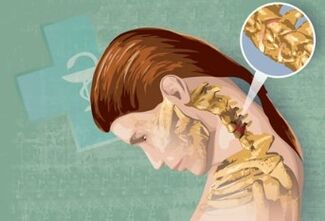In the modern world, the resonance of the disease of cervical osteochondrosis is difficult to overestimate.Osteochondrosis of the cervical region is much more common than in other vertebrates.This disease, to one degree or another, has almost all people over twenty -five years old.

Cervical osteochondrosis develops mainly due to a sedentary lifestyle, which is particularly facilitated by the historical transition of a person from physical labor to mental, which, albeit to a moderate degree, accompanies the performance of work in the sitting position.
Osteochondrosis of the cervical spine is a degenerative-dystrophic disease of the cervical spine, leading to the damage to the intervertebral discs, which is common for the disease of osteochondrosis.Since this section of the spine is due to its nature quite mobile, but also vulnerable due to a poorly developed muscle corset, therefore, any negative effect on the neck or back, does not affect the cervical region well.Due to the fact that degenerative changes are most often developing in the most mobile vertebrates, the nervous endings at the level of C5 ... C7 most often suffer in the cervical region.
Since the symptoms of cervical osteochondrosis are very contradictory, they are not always considered only as the symptoms of this disease, which quite often leads to the treatment of other fields of medicine for help.Consider them not more details.
Cervical osteochondrosis and its symptoms
Due to the fact that the cervical spine is quite compact, in comparison with its other departments, it is not even a large tension of the muscles of the Shei or the displacement of the vertebrae of the cervical region, it can cause squeezing or pinching of the nerve roots, which can also be subjected to the vessels located in this section.Well, osteophytes are bone growths, in folk treatment called the "deposit of salts" and formed in the conditions of the development of the disease of cervical osteochondrosis, lead, as a result, only to a significant deterioration in the course of the disease.
Clinical manifestations of the disease of cervical osteochondrosis, that is, its symptoms, can be divided into reflex symptoms and radicular symptoms of cervical osteochondrosis.
Reflex symptoms of cervical osteochondrosis
The reflex symptoms of cervical osteochondrosis include the so -called “shots”, expressed in the appearance of sharp acute pain in the neck, and significantly intensifying in any movements.In view of this, patients often take some forced, most comfortable, position of the head.In addition, the emergence of a typical “cryst” during turns or other movements of the head is also quite possible.

In case of cervical osteochondrosis, patients often experience headaches of compressive in nature and Irradium in the eyeballs or the temporal part of the head.In addition, sometimes at the same time, the severity of visual perception may fall, as if "everything floats before my eyes."
The vertebral artery syndrome can also develop, when its nervous plexus is irritated, which very often, due to dizziness in the patient, is erroneously diagnosed with a disturbance in the blood circulation of the brain.Such a symptom of cervical osteochondrosis can manifest itself with sharp movements of the head and complicate nausea and possible vomiting.
In addition to the above, the reflex symptoms of cervical osteochondrosis also include a cardiological syndrome in which sensations arise similar to an angina attack.But such a manifestation of symptoms of osteochondrosis is usually combined with the complex and other signs of this disease, so it usually does not cause difficulties in making the correct diagnosis.
Rimed symptoms of cervical osteochondrosis
The radicular symptoms of cervical osteochondrosis, as a rule, appear due to compression of the spinal nerve ending - the spine.In this case, sensitive disorders affecting motor functions depend entirely on what specific nerve root is injured, namely:
- C1 - a decrease in sensitivity in the nape;
- C2 - the occurrence of pain in the parietal or occipital area of the head;
- C3 - impaired sensitivity and the appearance of pain in the neck, where the trauma of the spinal spine occurred with a very possible impaired speech function, due to loss of the sensitivity of the language and control over it;
- C4-the appearance of pain and a decrease in sensitivity in the shoulder-lopate spinal area, as well as pain in the heart and liver, with the simultaneous decrease in the muscle tone of the neck and possible respiratory disorders of the respiratory function;
- C5 - a decrease in sensitivity and the occurrence of pain on the outer shoulder surface;
- C6-pain, Irradium from the cervical spatula, the outer surface of the shoulder, the forearm, and then from the ray-sail to the thumb of the hand;
- C7-the same pain as with C6, but Irradium from the shoulder blade on the back of the shoulder, and then from the forearm to the 2..4 fingers of the hand, with a decrease in sensitivity in the area of pain;
- C8 - a decrease in sensitivity and pain going from neck on the shoulder, and then from the forearm to the little finger of the hand.

Cervical osteochondrosis and its treatment
Cervical osteochondrosis is a rather complex and extremely unpleasant disease, for the treatment of which systematicity, duration and stage are necessary.Therapeutic treatment of cervical osteochondrosis, first of all, is aimed at the complete cessation of pain symptoms of cervical osteochondrosis and the elimination of inflammation in the neck affected by the disease.
Patients, in the treatment of cervical osteochondrosis, are carried out by classic analgesics.Although recently in the treatment of osteochondrosis of the cervical spine, non -steroidal anti -inflammatory drugs effectively relieves pain and reducing the activity of inflammation, in the treatment of osteochondrosis of the spine.
Among other things, Chondroproprotectors are also used in the treatment of cervical osteochondrosis, which slow down the process of destroying cartilage tissue and, according to so many specialists who also contribute to the process of regeneration.In addition, patients are prescribed by the use of vitamins B that improve metabolic processes in the patient's body.
But the use of external gels or ointments for the treatment of cervical osteochondrosis is not effective, but the meaning, since in the process of rubbing into the skin an additional massage of the cervical spine is also performed.
Additionally combined with traditional drug treatment for cervical osteochondrosis, physiotherapy procedures are, and in particular, the use of magnetotherapy is especially effective through special medical devices, for example, a domestic apparatus that has gained well -deserved glory among specialists and patients.It is also applied, in addition to the above, still therapeutic massage, physiotherapy exercises and manual therapy.But, in particularly severe cases of the disease, surgical intervention may be required.
Prevention of the disease of cervical osteochondrosis
The prevention of cervical osteochondrosis in itself is not complicated.Recommended:
- conducting an active and healthy lifestyle,
- playing sports, or at least morning gymnastics,
- competent organization of the workplace,
- compliance with the regime of work and rest,
- With prolonged work in a sitting position - during the working time, perform a warm -up several times and ensure the correct position of the head and posture during work.
The selection of a comfortable pillow and mattress for sleeping is also important.But to those who are already suffering from this ailment, everyday use for a comfortable sleep of specialized orthopedic products is strongly recommended.





















